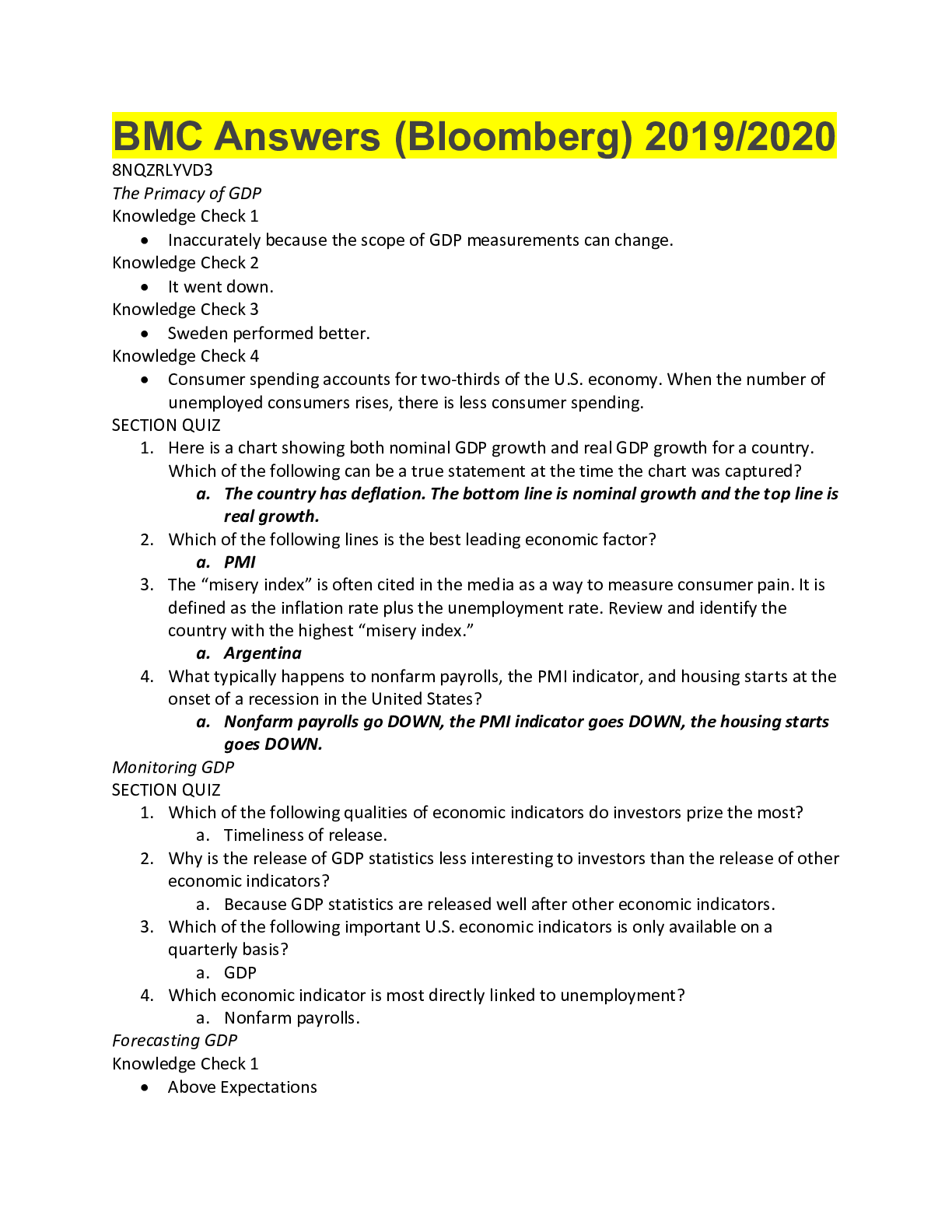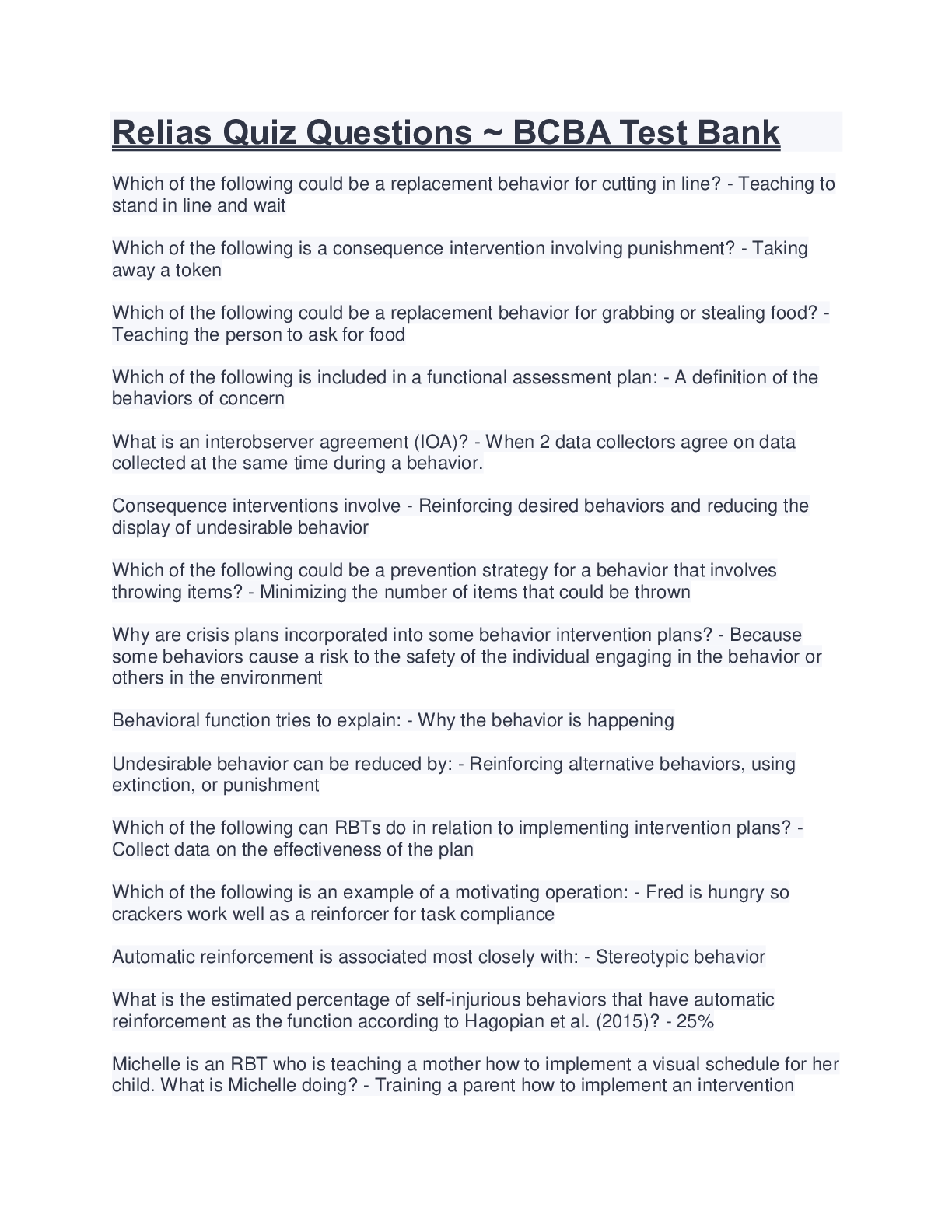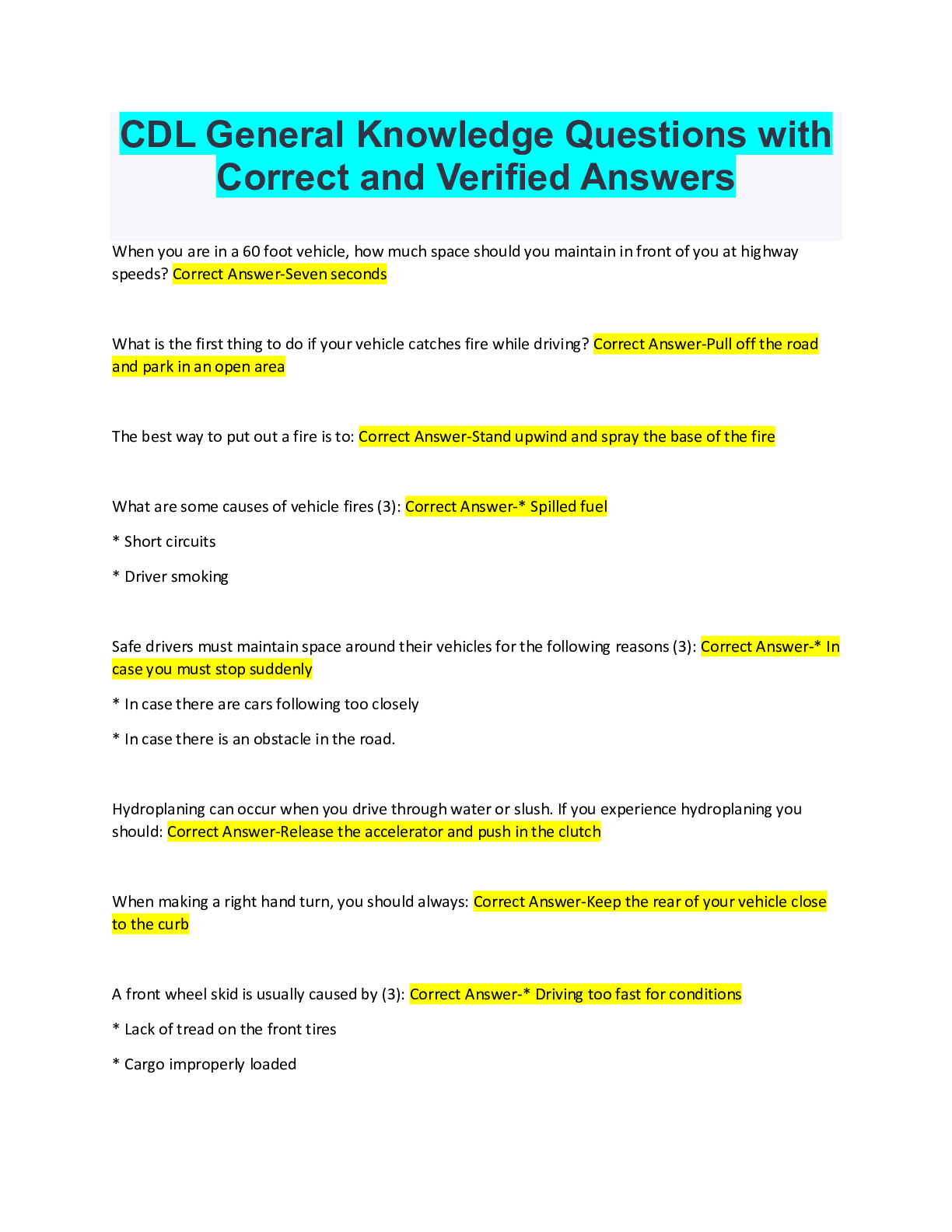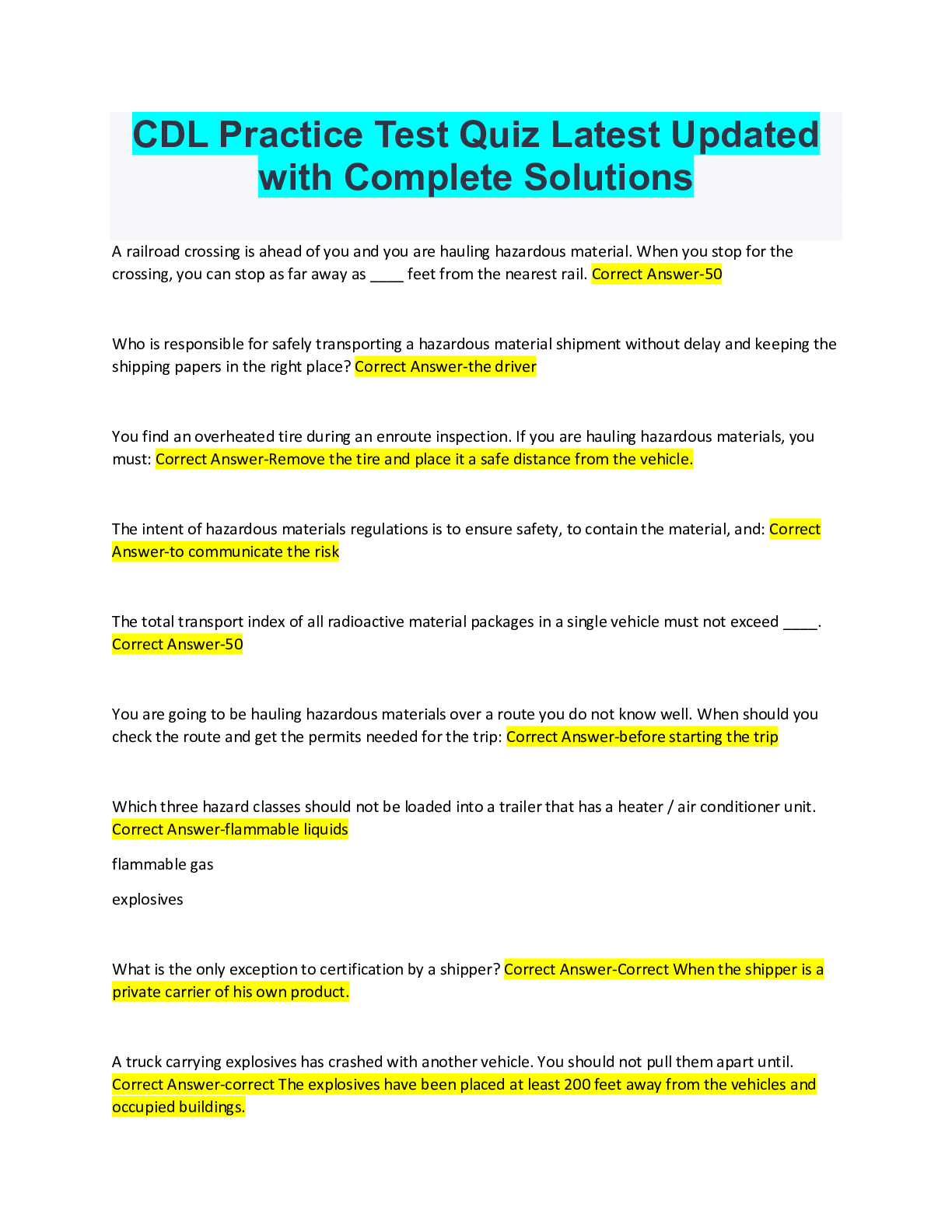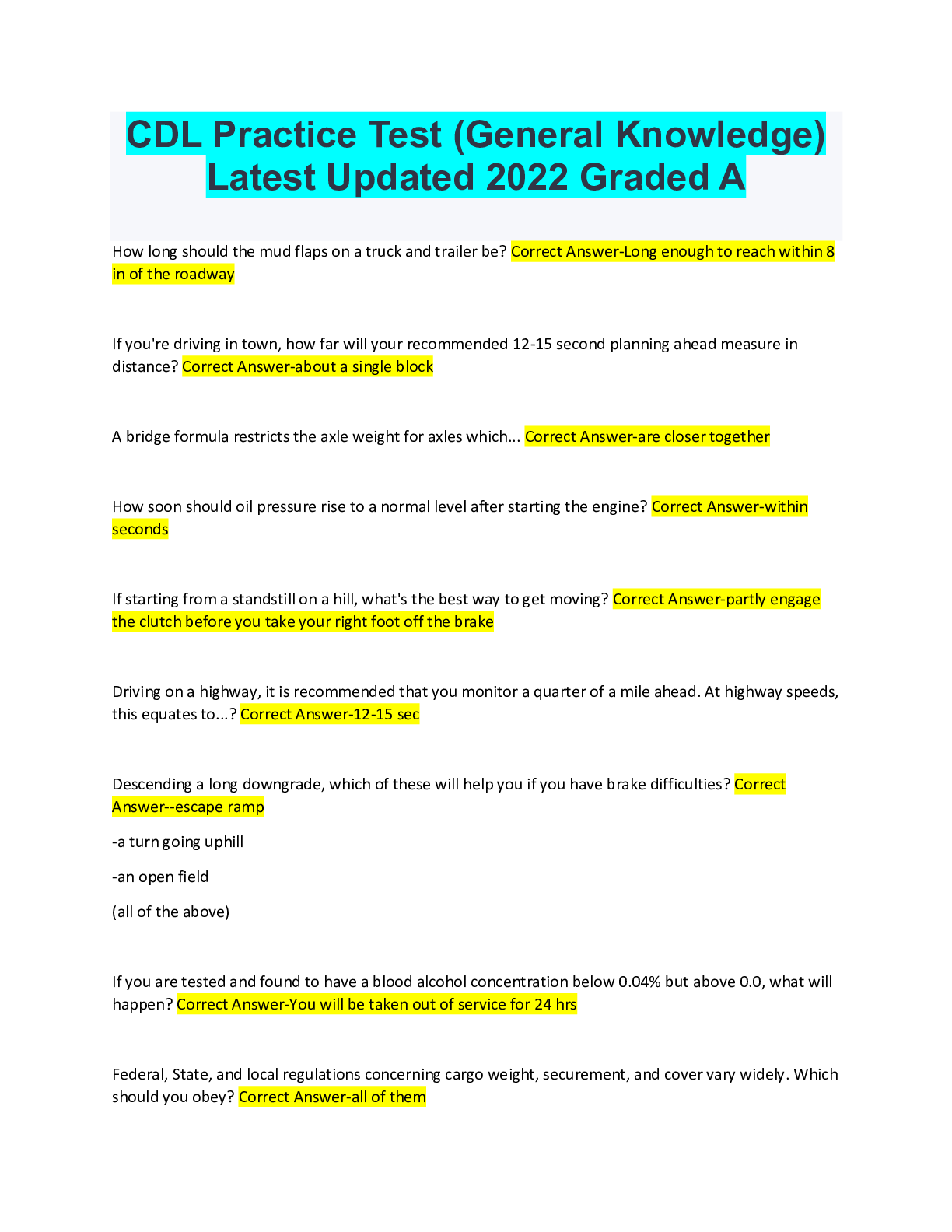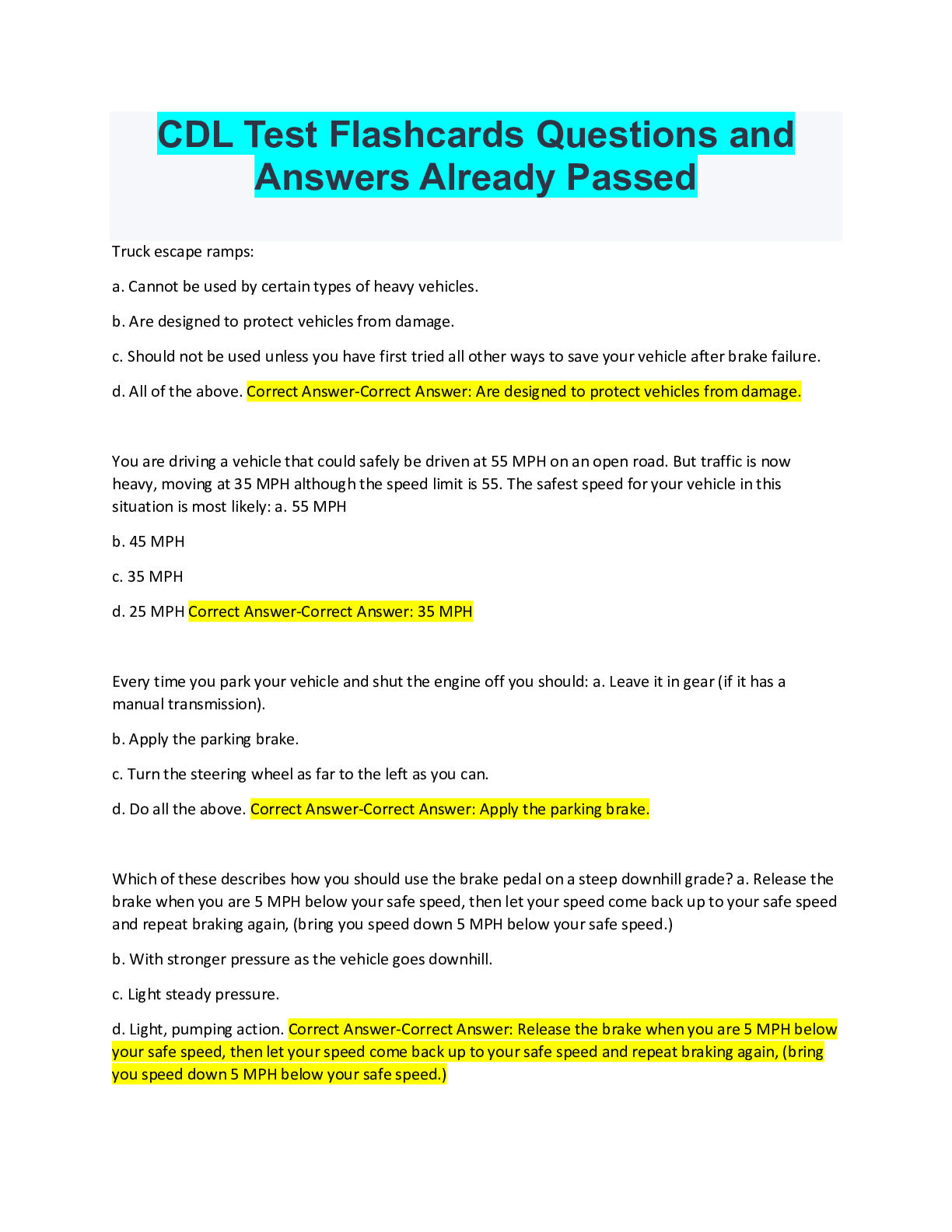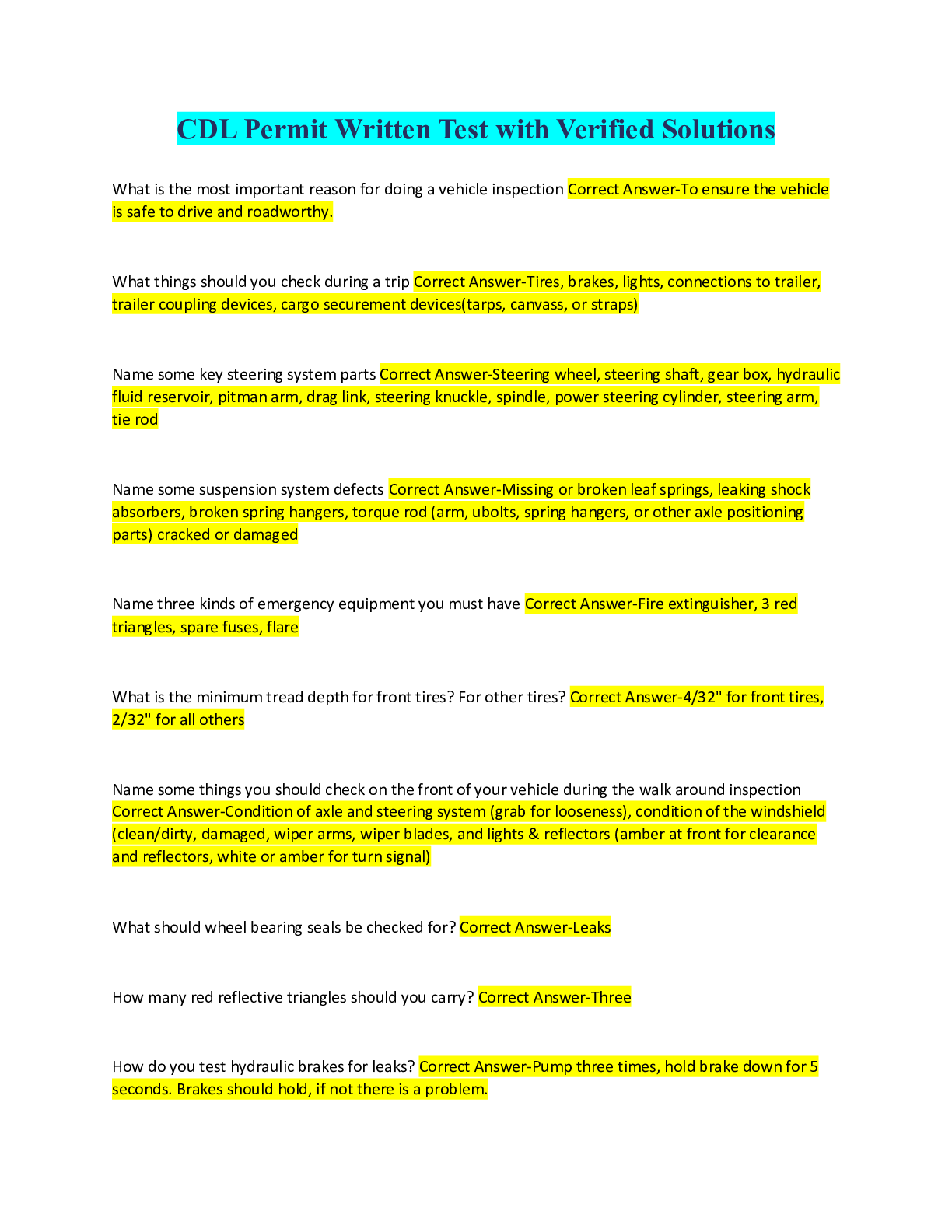Law > QUESTIONS & ANSWERS > WGU C181 STUDY GUIDE. 100% comprehensive paper. rated A (All)
WGU C181 STUDY GUIDE. 100% comprehensive paper. rated A
Document Content and Description Below
WGU C181 STUDY GUIDE Chapter 1 ✔✔ What is sovereignty? ✔✔SOVEREIGNTY - Each national government has the right to govern its people as it wishes, without interference from other nations. Ho... w is Sovereignty threatened in the globalized world? ✔✔If the majority of nations thinks a country is being ruled unethically or crimes on its citizens are happening, world sanctions can be ordered. IE... Libya and Moammar Gadhafi. What are the fundamental values of American democracy? How are these values shown in the two dilemmas of government? ✔✔Order, freedom and equality. Freedom vs. Order- sometimes, order is needed to have freedoms. USSR, Germany. Freedom vs. Equality- sometimes, equality is a problem and hurts freedom. Equal pay, School busing. How do equality of opportunity, equality of outcome, and political equality differ? Provide examples. ✔✔Equality of Opportunity- Same chance to succeed. School, employment. Equality of Outcome- Same outcome for work. Equal pay, Healthcare. Political Equality- Have a voice. Vote, Run for office. What are the major purposes of government? Which is most controversial? ✔✔Order, Freedom and Equality for all. Order is the biggest issue without giving up freedom. Figure 1.1 fill out the following chart: Political theory ✔✔1. Definition, 2. Correspond to which Economic Theory? - Define theory 3. Corresponds to which political label in the U.S.?Anarchism ✔✔1. total freedom. Law of the Jungle. 2. 0% government. Laisser Faire. 3. Not applicable. Libertarianism ✔✔1. want freedom with little laws. Liberty 2. 20% government. 3. Libertarian. Liberalism Power of the people to change laws. ✔✔1. wants freedom, kn ows laws are needed, wants everyone equal. 2. 30-40% government. Capitalism, no monopolies. 50-75% government. Socialism. 3. Conservatives - Republicans, Communitarians, Liberals - Democrats Totalitarianism ✔✔1. wants nothing but law & order. 2.100% government. Communism. 3. Not applicable. Figure 1.2 ✔✔State the differences between libertarianism, conservative, communitarian, & liberal views on Freedom, Order, Equality, & Government. Which values are seen as most important? Least important? What role should government play to protect those values? Freedom ✔✔Libertarianism- almost all freedom Conservative- 1/2 freedom Communitarian- very little freedom Liberal-very little freedom Order ✔✔Libertarianism- very little of law & orderConservative- 1/2 law & order Communitarian- 1/2 law & order Liberal- very little order Equality ✔✔Libertarianism- very little equality Conservative- little equality Communitarian- 1/2 equality Liberal- almost all equality. Government ✔✔LibertarianismConservativeCommunitarianLiberallibertarianism ✔✔Wants mainly freedom with little law & order and equality. liberalism ✔✔Wants a balance of freedom, equality and law & order. liberals ✔✔wants mainly equality with little law & order and freedom how they similar and differ? ✔✔They understand Freedom, Law & Order and Equality are needed. It is the amount of each that separates them. Chapter 2 ✔✔ What are the types of 'Direct Democracy'? ✔✔All citizens run the government and vote on laws, taxes and issues. Small towns, clubs, teams, etc..What is 'Indirect Democracy' or Representative Democracy? ✔✔All citizens vote for someone to represent their thoughts. Our government, Representative, Republic system. What are the basic concepts of Majoritarian democracy (Majoritarianism)? ✔✔Majority rules. Everyone is equal to vote and have the chance to vote. Know what you are voting for, be consistent and vote to have your voice heard. What are the basic concepts of Pluralist democracy (Pluralism)? ✔✔Interest groups vote for the laws, issues and what should be done. Majority is silent, the interest groups vote, government should listen to only them. How does "Elite Theory" differ from the Majoritarian and Pluralist models? ✔✔The view that a small group of people actually makes most of the important government decisions. Chapter 3 ✔✔*When you are logged into the Learning Resource, please review the Interactive Timeline, The Constitution: The American Revolution and the Nation's Constitution. Explain Thomas Jefferson's ideas on unalienable rights and the Social Contract Theory as found in the Declaration of Independence. ✔✔He was the writer. All man has a right to Life, Liberty and the pursuit of Happiness (property), Self-governing. -How was Thomas Jefferson influenced by John Locke? ✔✔Locke believed, man has God-given rights (inalienable) and government is to protect and ensure these rights for all. What is the relationship between the right to vote, popular sovereignty and Republicanism (or a republic)? ✔✔Everyone has a right to vote to show popular sovereignty and gaurantee the republic is not ruled by one person or group. What were the political and economic weaknesses in the Articles of Confederation? ✔✔No tax power.No leadership. No regulated trade. Amendments had to have a unanimous vote. How did trade wars and events like Shay's rebellion expose some of these weaknesses? ✔✔They showed the government had no power to raise money or to protect the new country. How may the failure of the Articles of Confederation be seen as giving rise to the U.S. Constitution? ✔✔It showed the government needed powers to raise money, make trade laws, raise a national army and have states have powers. Explain the Virginia Plan and the New Jersey Plan as well as key differences. How were those differences resolved in the Great Compromise? ✔✔ -Virginia Plan ✔✔-That the powers of the government be divided among three separate branches: a legislative branch, for making laws; an executive branch, for enforcing laws; and a judicial branch, for interpreting laws. -That the legislature consist of two houses. The first would be chosen by the people, the second by the members of the first house from among candidates nominated by the state legislatures. -That each state's representation in the legislature be in proportion to the taxes it paid to the national government or in proportion to its free population. -That an executive, consisting of an unspecified number of people, be selected by the legislature and serve for a single term. -That the national judiciary include one or more supreme courts and other, lower courts, with judges appointed for life by the legislature. -That the executive and a number of national judges serve as a council of revision, to approve or veto (disapprove) legislative acts. Their veto could be overridden by a vote of both houses of the legislature. -That the scope of powers of all three branches be far greater than that assigned the national government by the Articles of Confederation and that the legislature be empowered to override state laws.-New Jersey Plan ✔✔-That a single-chamber legislature have the power to raise revenue and regulate commerce. -That the states have equal representation in the legislature and choose its members. -That a multiperson executive be elected by the legislature, with powers similar to those proposed under the Virginia Plan but without the right to veto legislation. -That a supreme tribunal be created, with a limited jurisdiction. (There was no provision for a system of national courts.) -That the acts of the legislature be binding on the states—that is, that they be regarded as "the supreme law of the respective states," with the option of force to compel obedience. -Great Compromise ✔✔-House would be dependent on state population. -Revenue-raising would start in the House. -Senate would be two senators from each state. -President and VP would be done by Electoral College. (#=# of Delegates) What are the four elements that form the foundation of the American political tradition in the Preamble of U.S. Constitution? ✔✔-Creates a People. "We the People of the United States..." -Explains the reason. "In order to form a more perfect Union..." -Articulates goals. "[to] establish Justice, insure domestic Tranquility, provide for the common defence, promote the general Welfare, and secure the Blessings of Liberty to ourselves and our Posterity.." Exists to promote order and freedom. -Fashions a government. "do ordain and establish this Constitution for the United States of America..." The four basic principles of the U. S. Constitution and in which Articles/sections & Amendments are they located? ✔✔ -Republicanism ✔✔form of government in which power resides in the people and is exercised by their elected representatives. Article 1:8-Separation of Powers ✔✔assignment of the lawmaking, law-enforcing, and law-interpreting functions of government to independent legislative, executive, and judicial branches, respectively. -Federalism ✔✔division of power between a central government and regional governments. -Checks & Balances ✔✔means of giving each branch of government some scrutiny of and control over the other branches. How do checks and balances work? *Also learn the Checks and Balances Chart. ✔✔Each branch can not have complete control or make its self more powerful than another. Specifically, what three powers are being separated in the principle of 'separation of powers'? ✔✔law-makers, judges and enforcers. Explain the main ideas in each of the seven Articles of the U.S. Constitution? ✔✔ -Article I ✔✔Tells what the congress job is, can and can't do. Longest and most detailed. -Article II ✔✔Tells what the presidency job is and what he/she can do. -Article III ✔✔Tells what the judges job is. Vage. -Article IV ✔✔All warrants/judgements be honored in every state, equality of all states citizens, allow new states to be created. -Article V ✔✔Amendments to be added to Constitution-Article VI ✔✔Supremacy Clause- which asserts that when the Constitution, national laws, and treaties conflict with state or local laws, the first three take precedence over the last two. -Article VII ✔✔Ratification Process- stipulating that approval by conventions in nine states would be necessary for the Constitution to take effect. What is the 'Necessary and Proper Clause' (or 'Elastic Clause') in Article I of the Constitution? ✔✔The last clause in Section 8 of Article I of the Constitution, which gives [Show More]
Last updated: 1 year ago
Preview 1 out of 26 pages
Instant download

Instant download
Reviews( 0 )
Document information
Connected school, study & course
About the document
Uploaded On
Sep 29, 2022
Number of pages
26
Written in
Additional information
This document has been written for:
Uploaded
Sep 29, 2022
Downloads
0
Views
54

















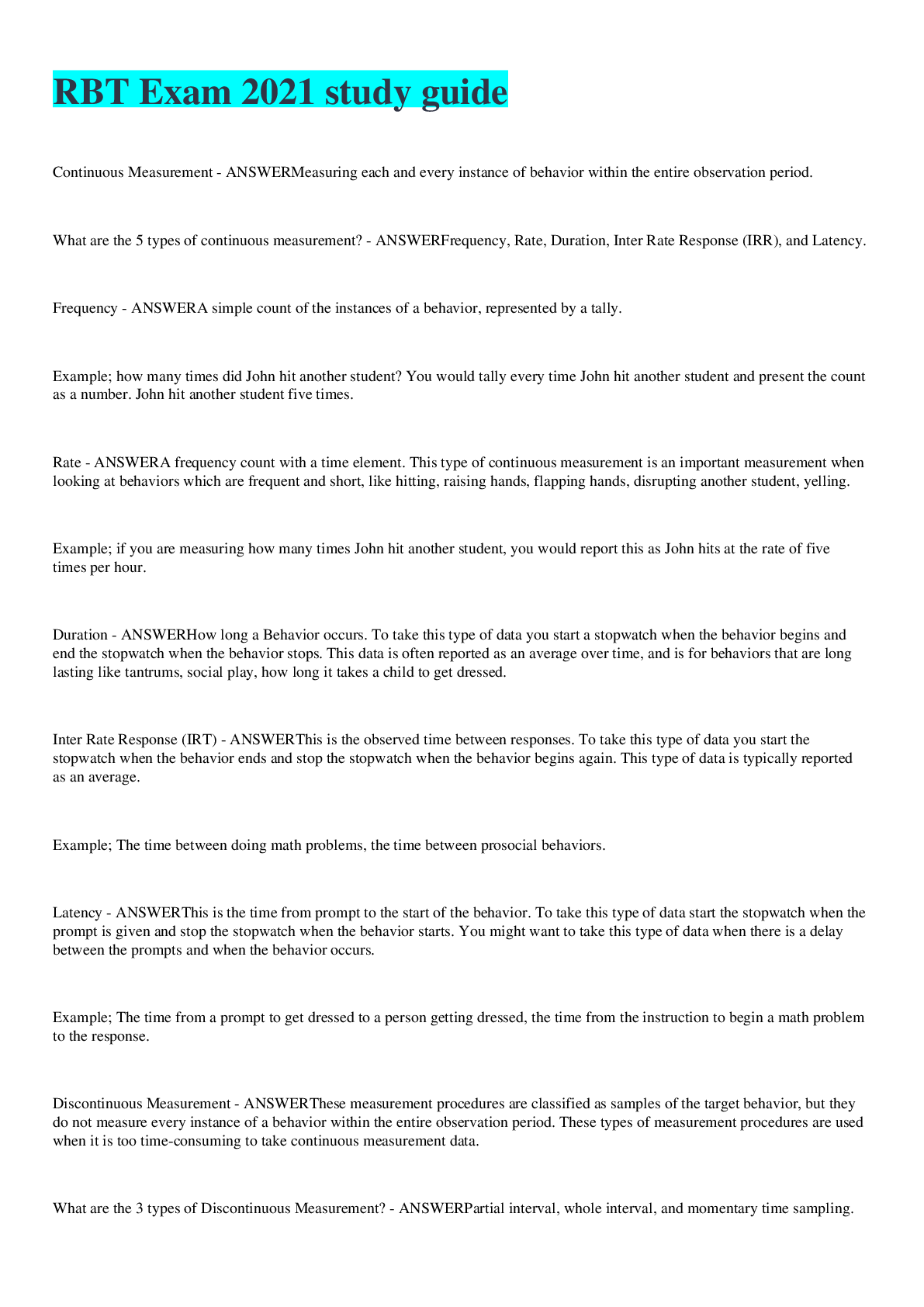
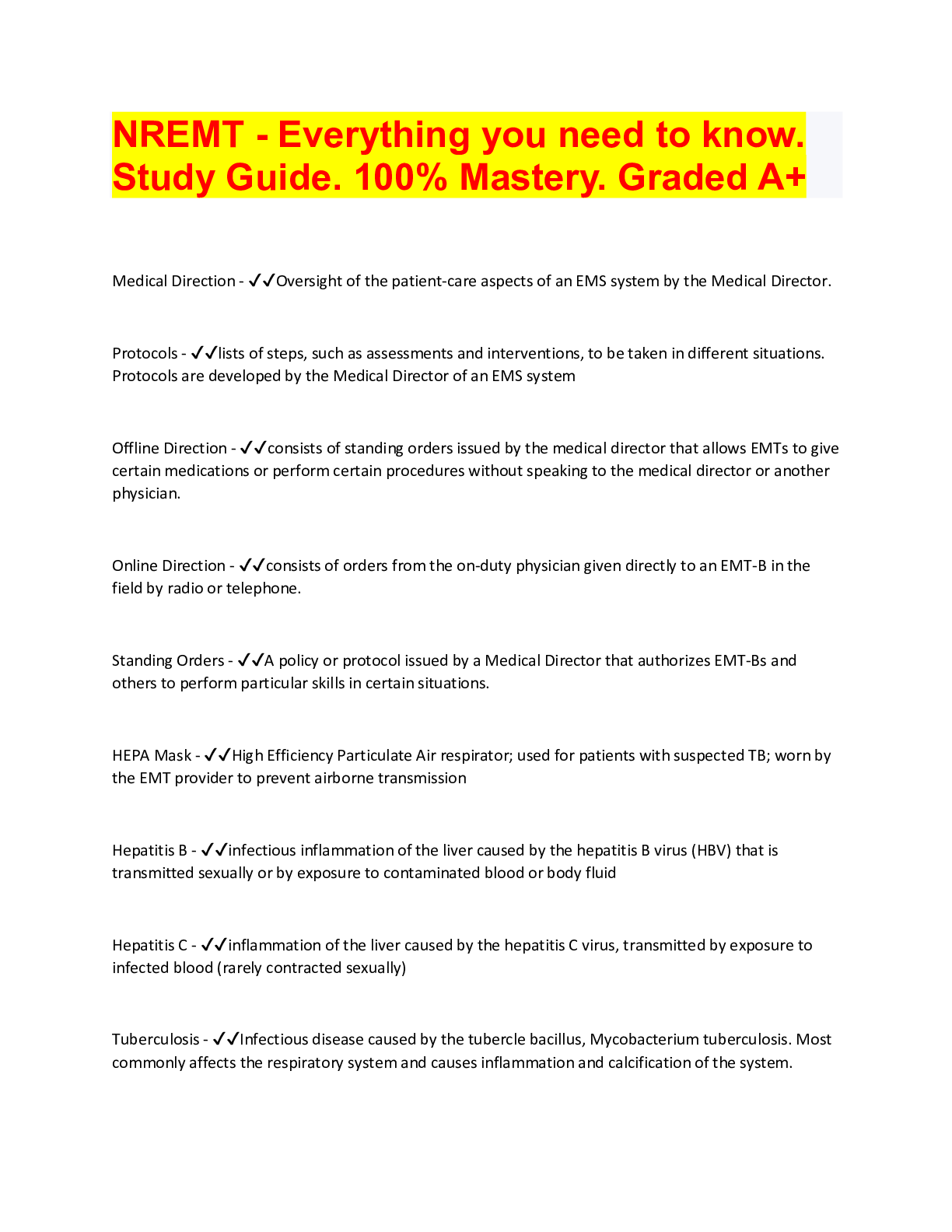
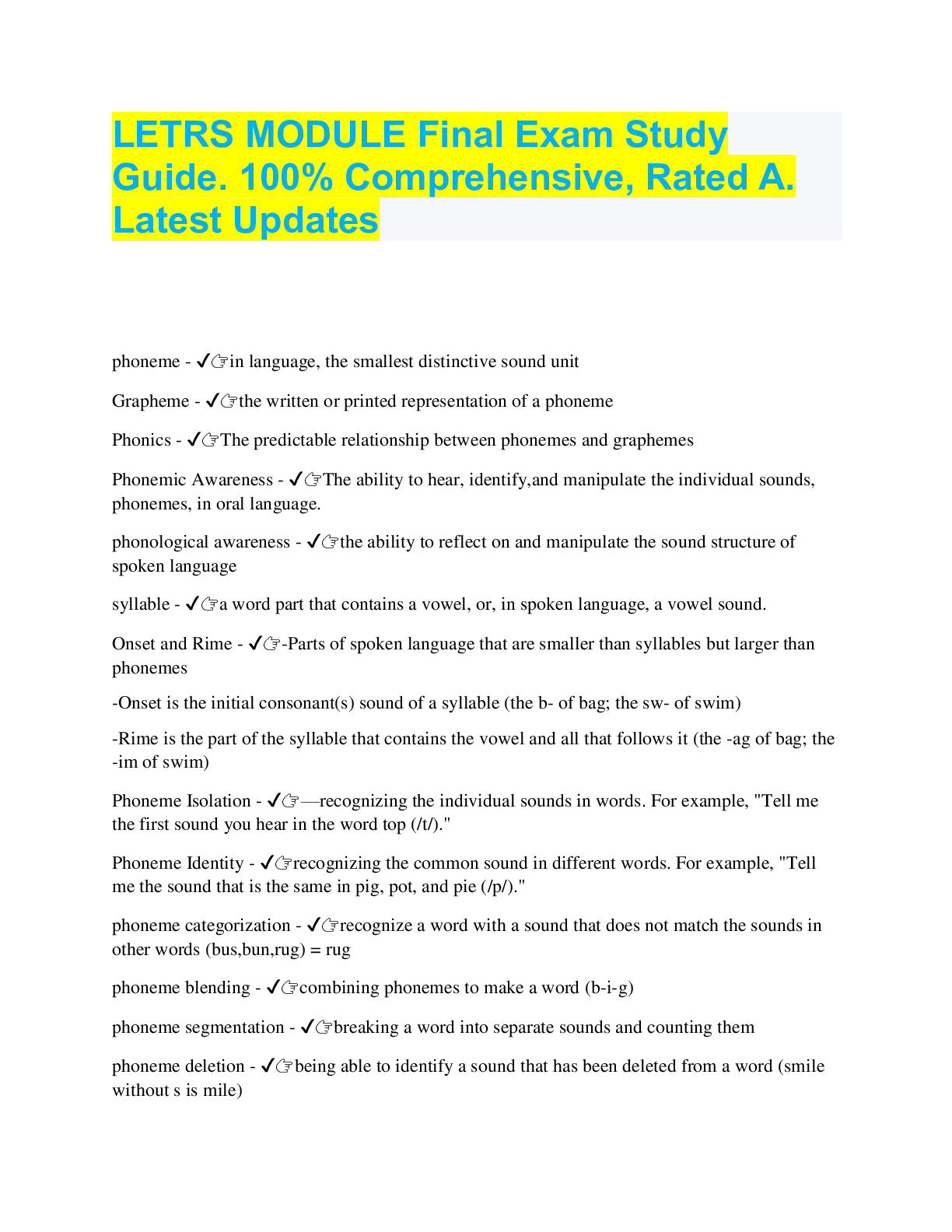
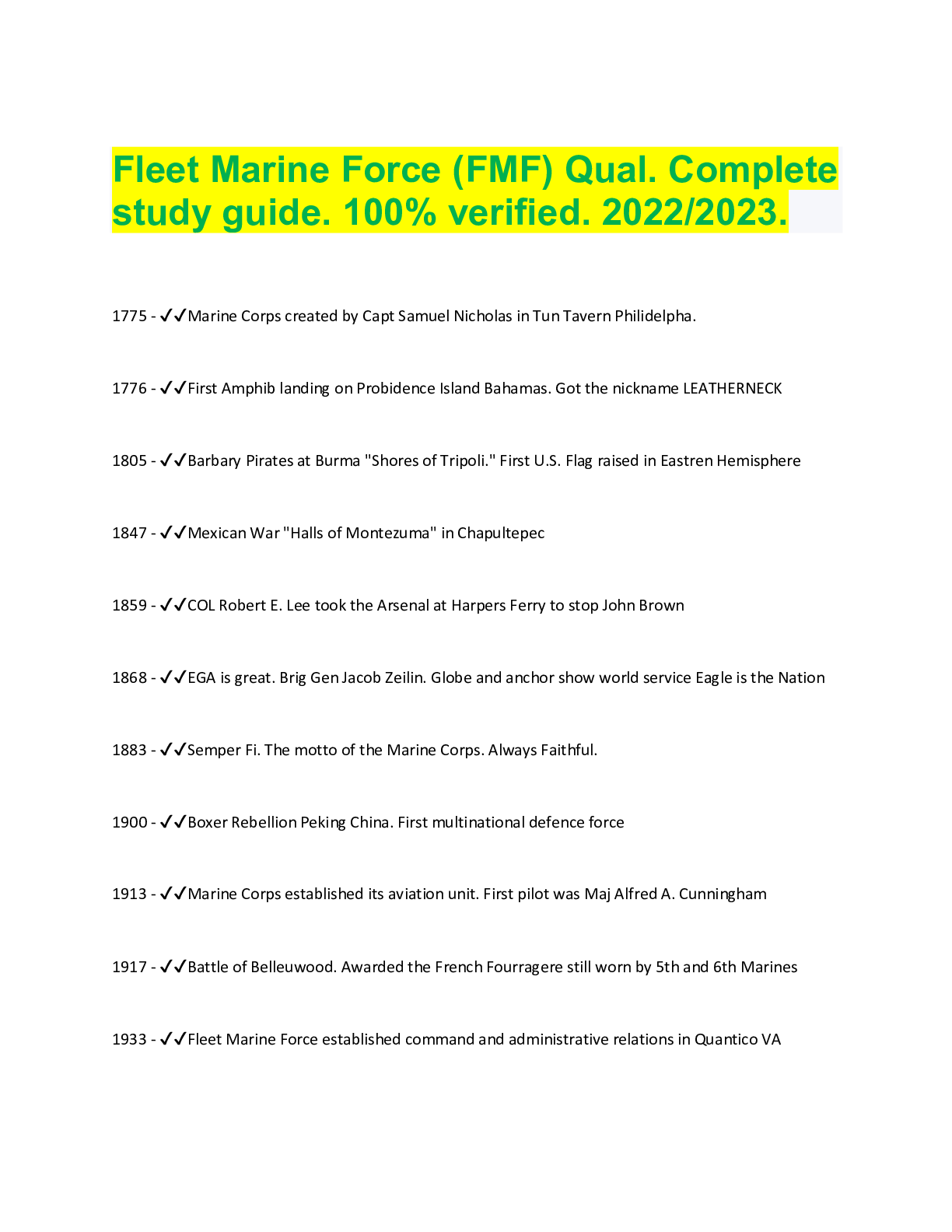
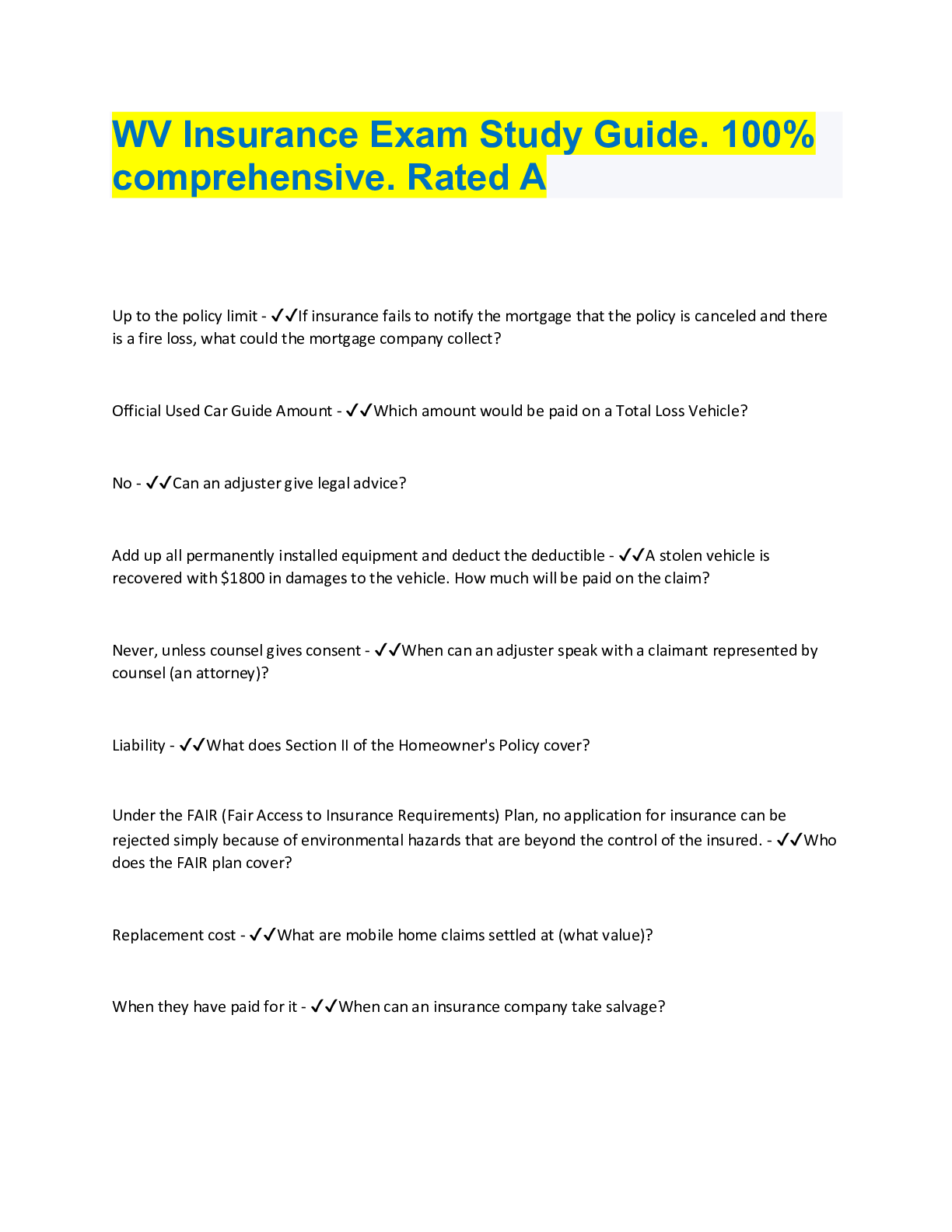
.png)
.png)
